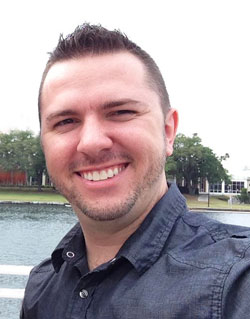 Recently, we heard about Matthew Strange, a landscape architect who has made the Curbed Young Guns semi-finals. Curbed Young Guns is in its first year, aims to identify promising up-and-coming talent (35 and under) in the fields of architecture, interior design, and urban development. We interviewed Matthew via email about making the Curbed Young Guns semi-finals.
Recently, we heard about Matthew Strange, a landscape architect who has made the Curbed Young Guns semi-finals. Curbed Young Guns is in its first year, aims to identify promising up-and-coming talent (35 and under) in the fields of architecture, interior design, and urban development. We interviewed Matthew via email about making the Curbed Young Guns semi-finals.
WLA: How does it feel to be nominated a Curbed young gun “in the fields of architecture, interior design, and urban development”?
I’m still sort of shocked, actually. The principal of my current firm, Tom Balsley, nominated me a few weeks ago – which was obviously a huge honor, but also very unexpected. He has been a great influence on me as a designer, so I’m truly grateful to him for the opportunity. It makes my upcoming move back to Hoerr Schaudt in Chicago even more bittersweet.
WLA: What was it at such an early age that triggered your interest in landscape architecture?
I’ve always been a creative person with a vivid imagination. In elementary school, while my friends were playing video games, I would be drawing out new characters and new game concepts. In middle school and high school, I would draw buildings and houses, and just became fascinated with designing spaces and imagining how people would use them. At the same time, I had a love of horticulture – and I fortunately had parents who allowed me to experiment with gardening and landscape design in their backyard (some experiments more successful than others). And so my interest in landscape architecture really came as a marriage between my love of designing spaces people could inhabit and horticulture they could enjoy.
WLA: How have your design ideas and interests changes since you graduated?
The good and bad thing about college is that you have the absolute freedom do design whatever you want with no real parameters, and without the voices of committees or city agencies influencing your choices. You also have weeks, and sometimes months of time to labor over a project. I’ve learned that this bears no resemblance to anything in reality. So I think where my design ideas have changed since school is realizing the importance of thinking outside the box while designing in the box, so to speak. I’ve learned to ask myself ‘how creative can I be within the parameters, budget, and time I’ve been given?’, rather than just design whatever seems interesting or trendy because you have limitless time and resources. A concept that is so bizarre that it could never make it through any real-life design process or stand up to public scrutiny isn’t a very strong concept in my opinion. I’ve learned great design balances functionality, program, and clarity with beauty, aesthetics, and imagination – drift too far into either extreme and the end product suffers.
This is something I’ve learned in some of my other creative interests as well. In addition to a landscape architect, I am a performing Christian spoken word poet and a freelance graphic designer. Effective poetry balances clarity and beauty, as does graphic design. Poets and graphic designers who drift too far into either end of the spectrum become either too boring for an audience to remember or too bizarre for an audience to understand.
WLA: As a young designer what is your advice to students and recent graduates about getting ahead in the profession?
I would say to never stop learning, and especially never stop learning to teach yourself. Within 5 years, the skills you learned in school will be obsolete. The industry is constantly finding more efficient and more effective ways of doing things, and it’s up to YOU (not your professor or your boss) to constantly push yourself to be better. I would also stress the importance of being well-rounded. Most landscape architects define themselves as either more design-oriented or more technical. But when you do that, you will find you quickly get pigeon-holed in an office as the designated ‘graphics person’, ‘CAD person’, etc. You will of course have your strengths and weaknesses, and there’s nothing wrong with playing to your strengths, but if you learn to do a variety of things well you will open up so many more opportunities for yourself.
WLA: What was your favourite project you have worked on at Thomas Balsley?
One of my favorites was SUNY Albany. I worked on two projects as part of a larger master plan – a new business school, and the entry spaces leading up to the campus. I think I like the project because it really combines both my love for design and my love for horticulture.
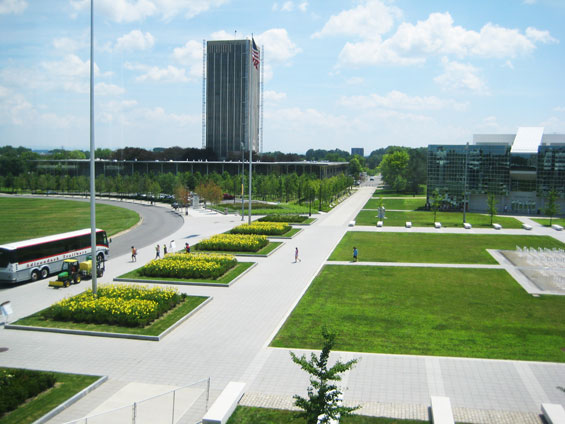
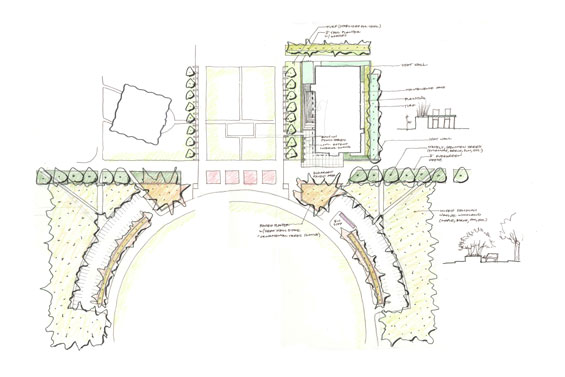
The entire campus, including most of the buildings, was designed by Edward Durell Stone. It’s unlike any other campus I’ve ever been to – everything is on a very strict orthogonal grid, and most of the materials are either concrete, white painted surfaces, or glass. But at the main entry to the campus is a large circular lawn that was flanked by two large groups of ailing pine trees. The campus planned to remove an existing parking lot and replace it with a new business school, and create two new parking lots located in the midst of the existing grove of dying pine trees as well as an additional lot on the eastern side of a dormitory. After dealing with the issue of a monoculture of trees all dying from the same disease, the school wanted us to make sure to include a variety of species…yet the architecture and orthogonal character of the campus seemed to suggest a monoculture would be a better option.
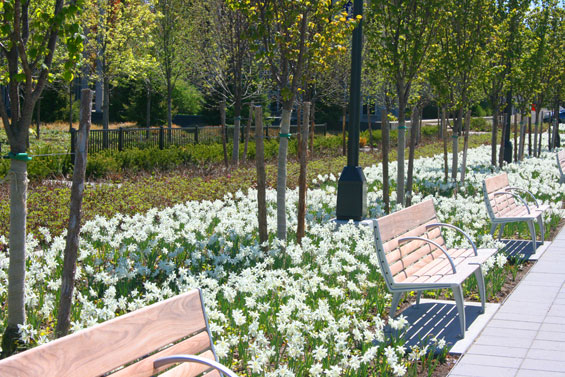
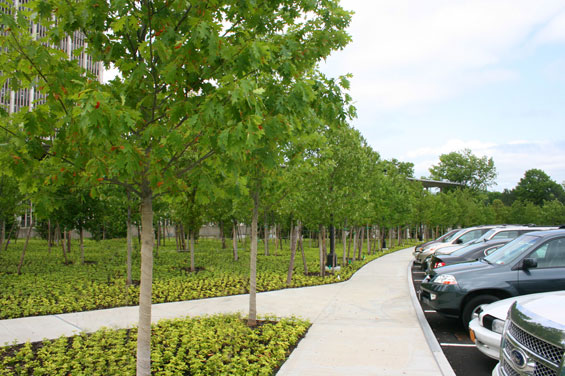
Our design solution was to create a native woodland to envelope the parking lots. But to do so, and still honor the campus aesthetic, we chose 3 species of trees with similar size and habits, so that from afar the grove of trees appeared to be a monoculture. We chose red maple, sugar maple, and red oak because they are very common species in the woodlands surrounding the campus – and we designed them on a radial grid to respond to the circular lawn. Over 330 trees were planted on a 15’ grid within a continuous bed of over 33,000 pachysandra, creating a substantial and ethereal scrim against the building that changes in character with each season. The trees help create a more human scale to the dormitories, while also providing dappled shade and something beautiful to look at.
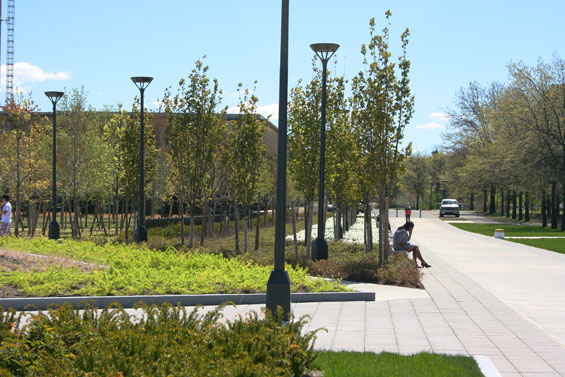
We designed the business school landscape as well as the corresponding pedestrian corridors that joined the building to the rest of the campus in a similar language of architectural planting. The trees, benches, and lighting all honor the relentless grid of the campus architecture, while massive linear bands of shrubs and herbaceous planting add texture and a sense of dynamism to animate the campus space. The business school joins to a small campus quad and fountain (designed by Thomas Balsley Associates prior to my involvement with the project) and featured a small entry plaza as well as a lower level sunken plaza articulated with terraced gabion retaining walls. The area immediately surrounding the new business school is currently under construction and will be completed in the coming months.
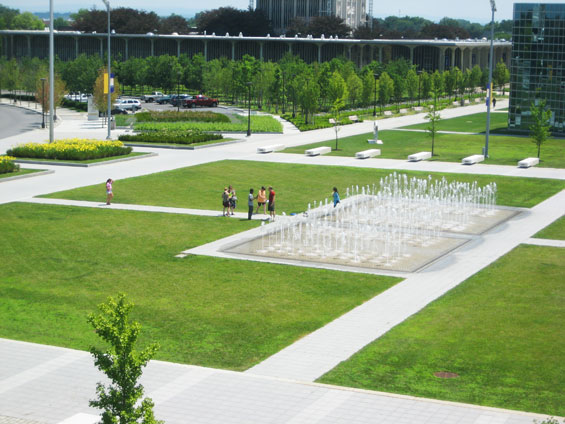
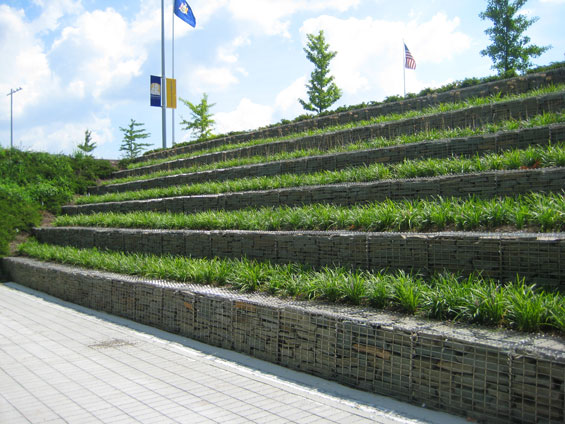
Thanks to Matthew Strange for taking the time answer our questions and good luck with the Curbed Young Guns and your move back to Chicago.

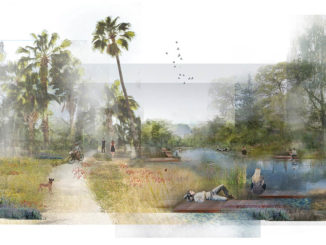
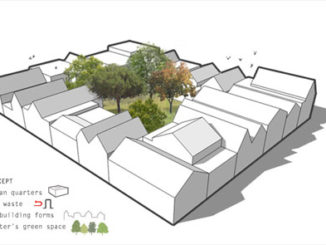
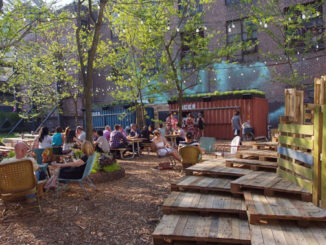
Comments are closed.